IN my last report I described the eight main levels on the tell in which excavations were made at the commencement of what has been a most successful season. During the rest of the season, now closed, we have worked only in the following levels: (1) Thothmes III—the level formerly termed ” Lower Pre-Amen-ophis III” is now seen to belong to this king; (2) Pre-Amenophis III; (3) Amenophis III; (4) Seti I; (5) Rameses II; and (6) Byzantine. The new finds proved most important, providing in the form of a number of new types of antiquities, together with interesting details concerning the temples of Thothmes III and a stela with the figure of a previously unknown Canaanite deity, evidence that Beth-Shan was one of the most important cities in Palestine as far back as three thousand four hundred years ago.
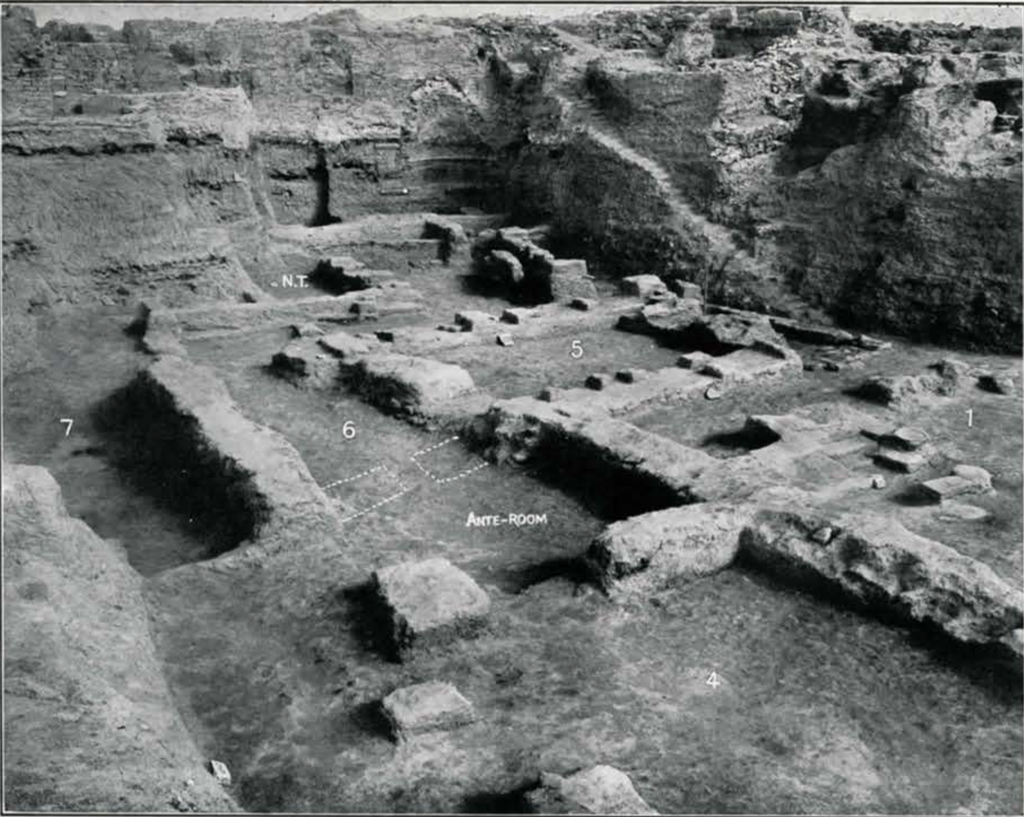
1. Thothmes III Level: 1501-1447 B.C.
On the floor of this level, which is nearly fifty feet below the original top of the mound, we found two scarabs of Thothmes III, one of faience, already referred to in the December JOURNAL, showing the figure of a bull with the royal cartouche above it, and the other of ivory, also with the cartouche of the king. These scarabs, together with certain other evidence, help to fix the date of the level.
Practically the whole of the excavated portion of the Thothmes III level is covered by the northern and southern Canaanite temples. So far as can be judged at present we have now cleared all the southern temple (the larger of the two buildings), with the exception of a strip along its western side, which will be removed in the coming season.

Image Number: 30160
The Southern Temple
The walls of the southern temple are made almost entirely of unhewn stones, covered as a rule with a single course of bricks. Upon the main walls low brick pedestals of various shapes form an entirely new feature in ancient architecture. It may be that the temple was screened in with wood and that the pedestals were used as supports for the posts, etc., holding the boards. Such screening with wood is an interesting possibility, being entirely unknown elsewhere in Palestine.
The new finds made in the following areas of the southern temple are:
The Inner Sanctuary. Near the altars in the sanctuary were various objects including two well made gold pins of Cypriote type; a steatite mould for articles of jewelry in the form of rows of concentric circles, etc.; two open single-spouted Canaanite lamps of pottery; and part of the head of a cylindrical cult object terminating in the head of a pig. A most valuable object, entirely new to Palestinian archaeology, was lying near the east side of the altar. This was a panelled Cretan altar stand of basalt having a cross with knobbed ends in high relief on its top; in Crete this “star” sign was a general indication of divinity.
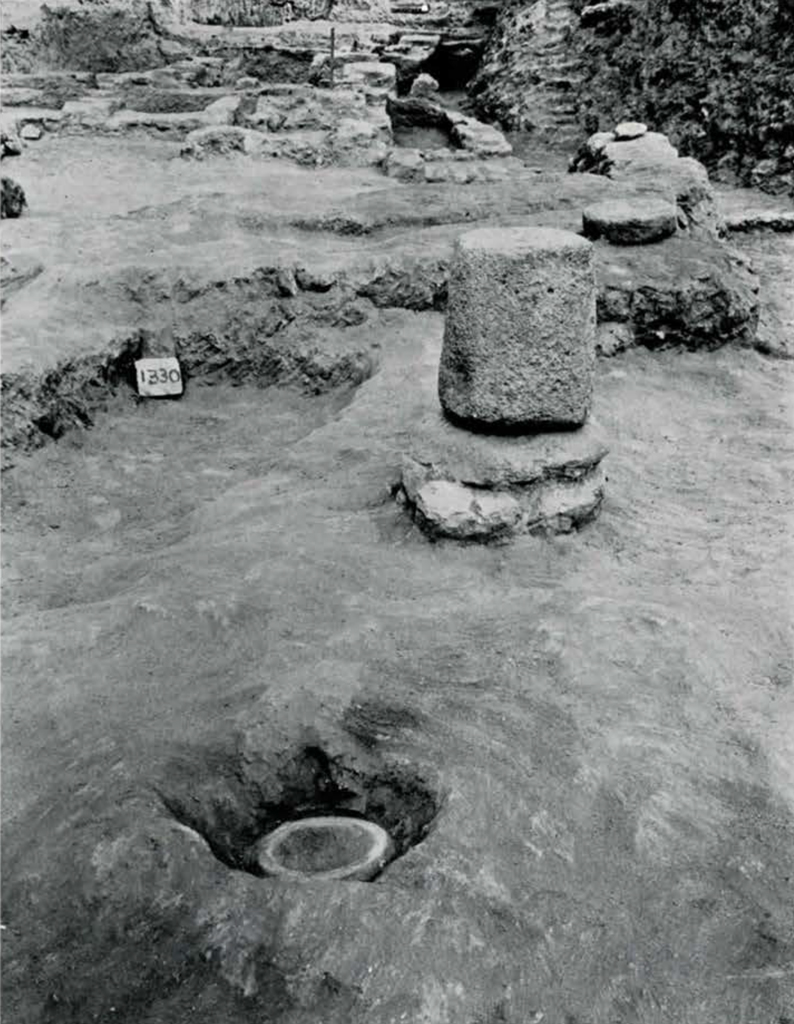
Image Number: 30016, 30174
The Southern Corridor. It is now quite clear that as the laity were not allowed to enter the sanctuary, which was reserved for the priests, this southern corridor of the temple was provided for their special use so that they could have access to and pour their libations upon the mazzebah, or sacred column, a cone-shaped stone object resting on a base of unhewn stones, the whole 2½ feet high. It was emblematic of the deity, and was found in a little room to the north of the east end of the corridor. About 3 feet 9 inches to the southwest of the mazzebah is a basalt libation bowl sunk in the floor. A channel doubtless once led from the mazzebah to the bowl, in order to convey to the latter the libations, probably of blood, made upon the sacred stone. The floor around the mazzebah and bowl is of brick. There are three small stone bases near the mazzebah, one being at the north, one at the west, and one at the east. These bases were doubtless stands for sacred objects. A fourth base, which is built against the west wall of the room containing the mazzebah, was perhaps the pedestal upon which the stela showing the figure of Mekal, the god of the temple, was placed. The stela, which was found in the upper debris a little to the west of this point, will be fully described below. Here it may be mentioned that whereas the mazzebah, in accordance with Canaanite usage, sufficed for the local peoples as the emblem of their deity, a stela showing the deity in a human or animal embodiment was necessary to the Egyptians who could hardly visualize a god otherwise. As a matter of fact the whole of the Thothmes III southern temple really forms a combination of an old Canaanite “high place,” which was usually a crudely walled sanctuary open to the sky, enclosing sacred columns and a temple with altars, etc. Perhaps the “high place” section of the Thothmes temple, i.e., the part containing the mazzebah and the libation bowl, formed the original sanctuary in the level, the rooms with the altars, etc., having been added at a later date. It may well be that the mazzebah was brought up from a “high place” in an earlier level on the tell.
An interesting object discovered in the corridor was the snout portion of a pottery hippopotamus, perhaps from a cylindrical cult object. A complete figurine of a hippopotamus was found in the Seti I level in 1925. The hippopotamus was of course associated with the god Set.
Room North of Inner Sanctuary. On the northern and southern walls of this room are several brick pedestals; and on the western wall, in which there is a door leading into the corridor connecting the anteroom of the courtyard of the southern temple with the northern temple, there are other pedestals. On the eastern wall also were found pedestals, together with a socket for a pole. Traces of the pole itself were found near the socket, but what the pole was used for we do not know. On the floor near the northeastern outside corner of the room we discovered a fine head of a basalt statuette of a personage, perhaps a deity, with a wig. This is Egyptian in origin.
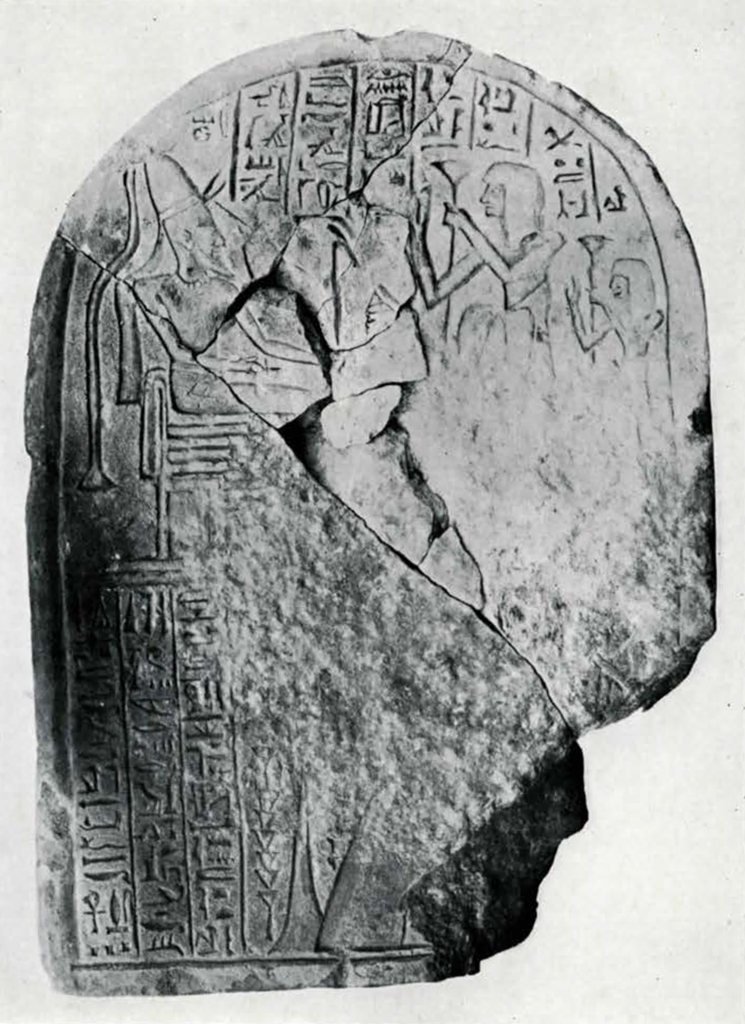
Image Number: 142741, 30012, 30175
Stela of Mekal, the god of Beth-Shan
The stela found near the mazzebah in the southern temple of Thothmes III is nearly a foot in height and about 8 inches in width; and although it is thus rather small in size, yet the information it contains is of great value, as it gives us the actual name and epithet of the god who was probably worshipped in the temple itself, that is to say, ” Mekal (or Mekar), the god of Beth-Shan.” From the inscriptions we learn that the monument was made for a builder named Amen-em-Apt by his son Pa-Ra-em-Heb, the former of the two names meaning, literally, ” The-god-Amen-in-Karnak” and the latter, “The-god-Ra-in-Festival.”
Upper Register of Stela. On the upper register of the stela is represented Mekal or Mekar seated on a throne holding the was-sceptre of “happiness” in his left hand and the ankh-symbol of “life” in his right. He wears a conical helmet with two horns attached to the front. The helmet is Babylonian in appearance, and is also much like the helmet with two horns worn by the god Set or Sutekh (who holds the ankh and the was) figured on a stela from Sinai.1 Affixed to the back of Mekal’s helmet are two streamers, one at the top, and the other at the base. These streamers, which likewise must have originated in Babylonia, are also a feature of the headdress of various other Canaanite deities portrayed on Egyptia monuments. Mekal is bearded and wears an ornamented collar. Above him, in three lines of text, are written the words already quoted, “Mekal, the god of Beth-Shan.” Over the top of the sceptre is an emblem as yet unidentified. Between the sceptre and the face of the deity is depicted some object, now partly broken away.
In front of the god is a lotus which rested on an altar stand, now missing, but doubtless of the same type as that shown in the lower register. To the right are the figures of two persons, each presenting a lotus to the deity, the larger one being Amen-em-Apt and the smaller his son, Pa-Ra-em-Heb. The five lines of inscription above read: ” Made for the builder Amen-em-Apt, true of word, by his son, Pa-Ra-em-Heb.”
Lower Register of Stella. This originally contained four lines of vertical text, the last of which is now broken away but can quite easily be restored. The text, which is corrupt in places, probably reads about as follows: “A boon which the king gives to Mekal, the great god, that he may give to thee life, prosperity, health, fresh provisions (?), favour, and love, in order that thou mayest proceed in peace to the place thou reachest as a revered one. For the ka (‘double’) of the one favoured of his god, the builder Amen-em-Apt, true [of word. His son Pa-Ra-em-Heb].” The sentence in brackets contains the words I have restored in line four of the inscription.
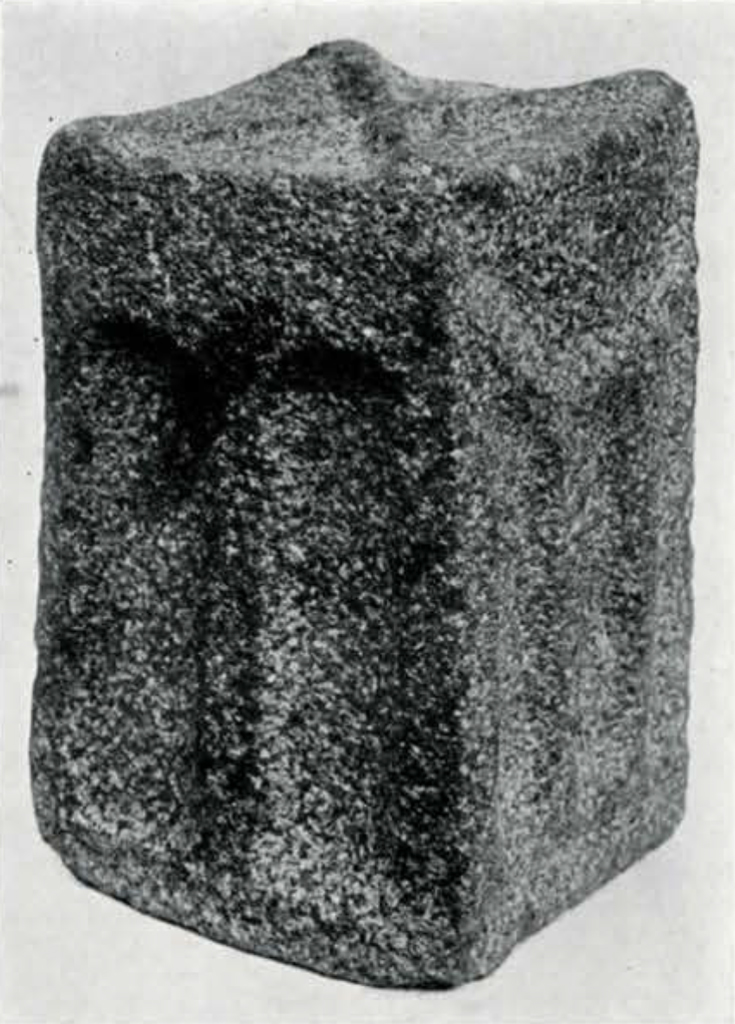
To the right of the hieroglyphs are a flower and an altar stand and also the lower part of the garment of the figure of Amen-em-Apt. Behind the builder is the upper portion of a small figure of a man who is doubtless his son.
As yet we know nothing definite from other sources about Mekal. In late Phoenician inscriptions found in Cyprus, there are references to a god called Mekel or Reshep-Mekel, the latter being translated into Greek as “Apollo Amyclaeus” who is usually identified with the Apollo of Amyclae in Lacedaemon. It is very doubtful whether this Mekel is a later form of the older deity Mekal worshipped at Beisan. The god on the Beisan stela is dressed in the same way as a representation of Resheph on a stela in the Berlin Museum,2 who wears a conical crown with a streamer and two horns, and holds the was-sceptre in his left hand and the ankh-sign of “life” in his right. But this god is identified with Sutekh, or Set, whom we have seen characterized by the same attributes; and Mekal of the Beisan stela may be a form of Resheph-Sutekh. Now resheph means “fiery shafts,” “burning heat,” “pestilence,” etc.; and mekal is possibly connected with the verb akal, meaning “to devour.”3 These attributes of Resheph, then, would be practically the same as those of Mekal, if he is to be regarded as “the Fierce Devourer,” whose name perhaps refers to the great heat and general unhealthi-ness of Beisan in summer. Or it may be that the word makal is an intentional transposition of the word melak or malek, i.e., Molech, the ” king,”4 the god of devouring fire and pestilence.
It is interesting to note that in the southern temple of Rameses II at Beisan (the “temple of Dagon” of I Chronicles x, 10) we found, in 1925, a cylinder seal bearing the figure of a god dressed like Resheph. He wears a conical crown with two streamers and the head of a gazelle attached to it, and holds a scimitar in his left hand and the sign of life in his right. That this god is the local deity Mekal in the form of Resheph there would now seem to be hardly any doubt.

The Northern Temple
The building which we have called the northern temple of Thothmes III is situated just to the north of the great southern temple, from which it is divided by a corridor. It is not yet fully cleared. There are four pedestals on its eastern wall and a dividing wall running across it from south to north. A flight of five steps leads up from a lower level to the north end of the temple; the purpose of the lower level cannot yet be ascertained. While the southern temple was dedicated to a god the northern was dedicated to a goddess—evidently the serpent deity. Nothing of interest has so far been found in the latter temple itself, but from certain rooms to the east of it came three faience cylinder seals showing figures of stags, men, sacred trees, etc.; a faience scarab bearing the figure of a seated person holding a lotus; a small model of a human hand in bronze, emblematic of the god Bes; small pottery models (votive offerings) of jugs, dishes and bowls; a model of a bull’s-head attachment from a kernos or hollow ring of pottery; and a wheel from the pottery model of a chariot.
For want of space only the following brief account can be given of the important finds in the five other levels on which the recent work has been done.
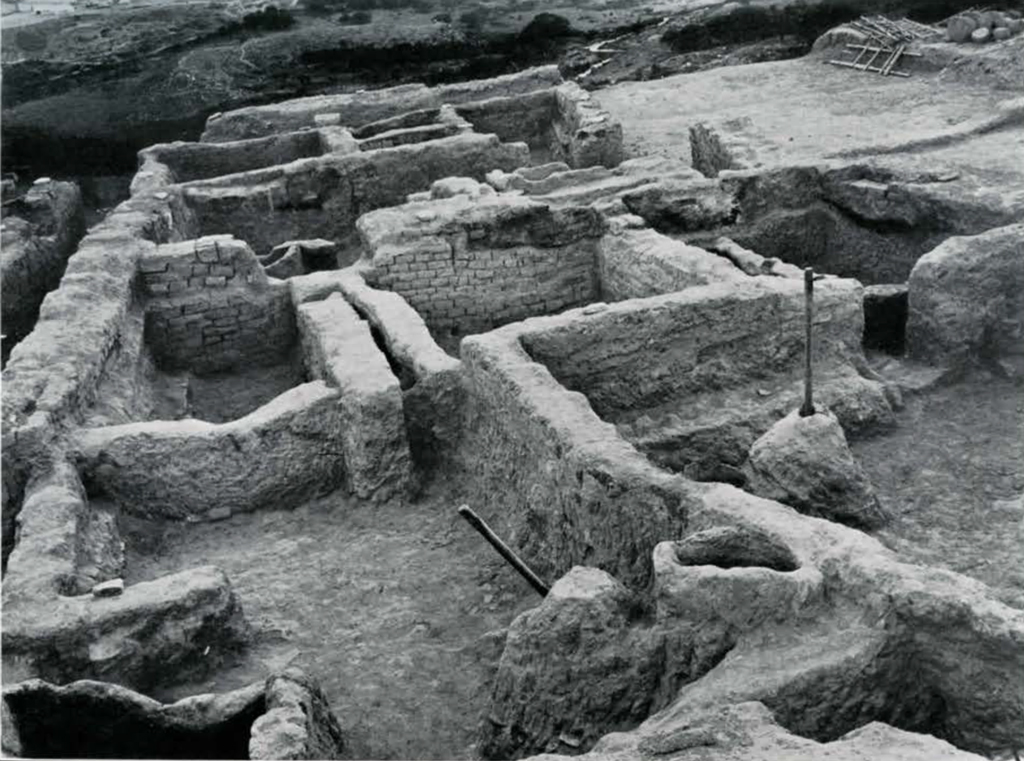
2. Pre-Amenophis III Level: C. 1446-1412 B.C.
The walls of this level, that between the strata of Thothmes III and Amenophis III, are very low, having been almost completely destroyed by later builders. Brick pedestals, similar to those in the Thothmes temples, were found on one of the walls, this being the latest example yet observed of their use. In the southern part of the level was a kitchen made of stones with a basalt water bowl in one end of it. Nothing was discovered in the kitchen, but in a small stone-lined receptacle a little to the south of it lay several mud models of cake offerings, some cylindrical and some like a thick disk with a hole in the centre. These were of course votive offerings to the deity—” cakes of the queen of heaven (Ashtoreth).” Not far from the receptacle was the head of an ivory figurine, perhaps representing the goddess Ashtoreth. Five serpent cult objects, two of them being serpents erect (like uraei) on small bases, one a serpent having human breasts with a milk bowl below them, one a serpent with human breasts and another serpent round its neck, and one the head of a serpent from a cylindrical(?) stand, were all connected with the ophiolatrous practices carried out in Pre-Amenophis III times. In view of the fact that the excavations have shown that Beisan was the centre of a great serpent cult in Palestine, one wonders whether its ancient name, “Beth-Shan,” or “House of Shan,” reflects a far distant connection with the old Mesopotamian serpent deity Shahan, Shakhan, or Sakhan. A deity with the name “Sha-an” actually appears in an ancient Babylonian letter.5 The UNIVERSITY MUSEUM possesses a cylinder seal (ca. 1900 B.C.) showing in male form the figure of this deity who is called “Shakhan, son of Shamash (i.e., the sun-god).” Behind him is the caduceus or staff with two serpents coiled around it.6 The deity appears elsewhere both in male and female form. From the various figurines of serpents with women’s breasts found at Beisan it seems fairly certain that the serpent deity of the town was a female one.
Other sacred things from the Pre-Amenophis III level comprise the snout from a pig cult object; a pottery mould for making figurines of the goddess Ashtoreth; a model offering pot of mud; a pottery model of a fish; and the upper part of a lifesized head of a deity in pottery. This deity has the hair on the head brushed back and very prominent eyebrow ridges, thus showing Mesopotamian influence. In the top of the head are four holes, in which, perhaps, actual plumes were inserted after the manner of the headdress of Ashtoreth portrayed in relief on a pottery cylinder found in the Amenophis III level (see below). A most interesting discovery consisted of three two-handled pottery cylindrical drain pipes. Two of them were actually found in situ beneath the floor of a street; they were both in a vertical position, the smaller end of the upper one being inserted in the larger end of the lower one. The mouth of the former drain pipe was originally on a level with the street floor, while the base of the latter rested upon a few undressed stones. These drain pipes are similar to the drain pipes with handles, of Middle Minoan I age (2100-1900 B.C.), found in Crete.
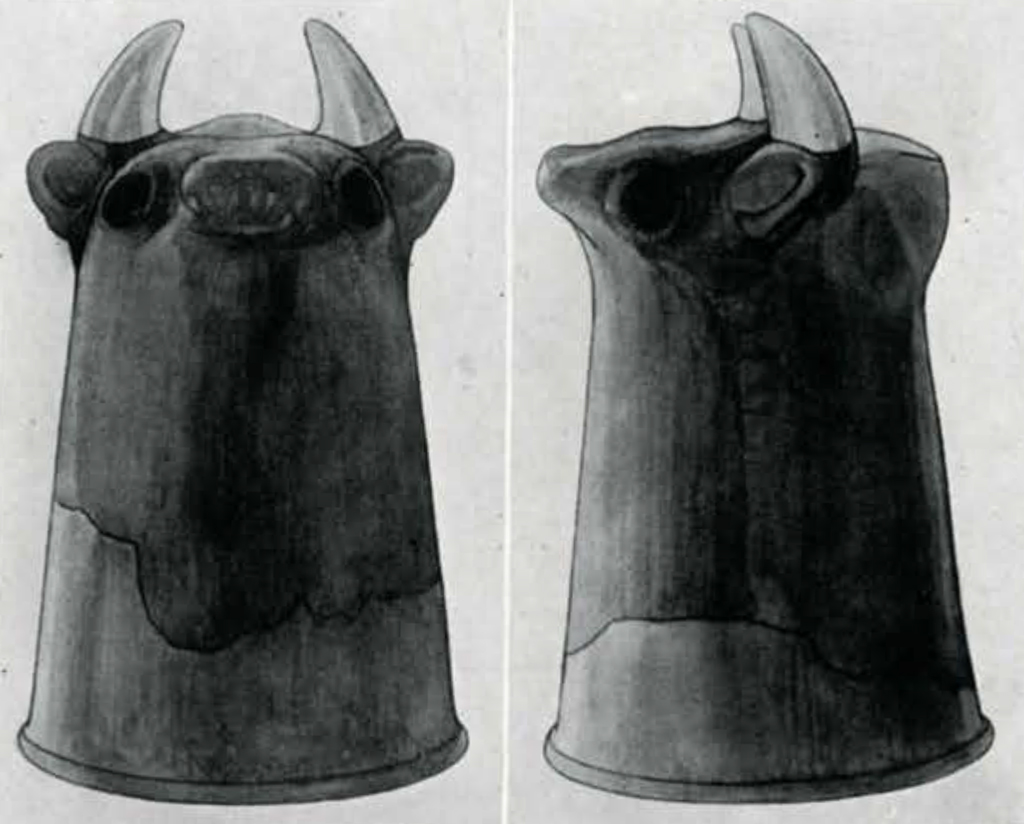
3. Amenophis III Level: 1411-1375 B.C.
The rooms of this level were generally in fair condition and had many of their brick walls standing to a good height, which was not far short of what they were when erected. Most of the walls were built upon small foundations of stone; while reeds were placed between some of the rows of bricks, the object being, no doubt, to strengthen the courses. The bricks were invariably laid stretcher by stretcher, and not stretcher by header alternately, which would of course have made a good bond. In spite of this, however, the walls have stood the test of time very well, so we must allow that the rather rough and ready methods of the old builders were excellently suited for the purpose to which they were put. A coating of plaster was usually placed over the faces of the walls. All the bricks are sun-dried, and one of them has a curved line on it, evidently a maker’s mark.
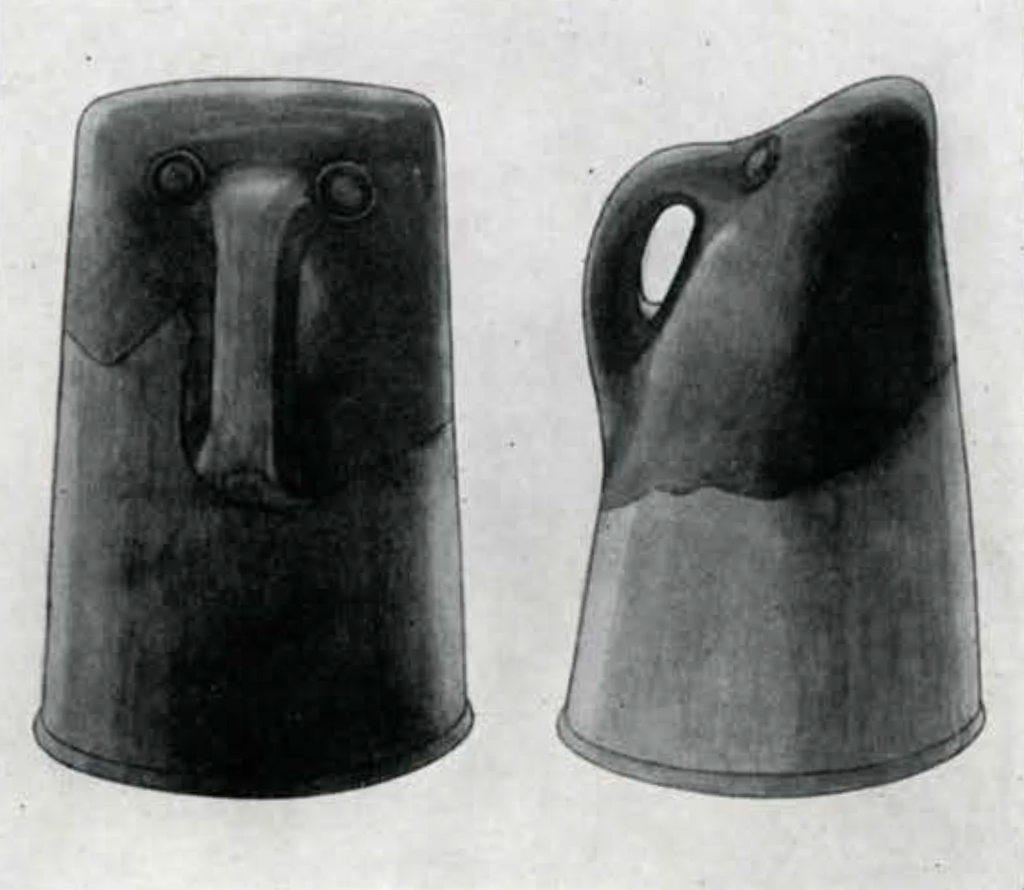
Three Canaanite Streets
At the south of the area was a narrow street, called by us “South Street,” which, after running from west to east near the southern edge of the tell, connected at a right angle with another street, “Main Street,” running to the north, thus dividing the area east of the Amenophis III temple into two parts. How far “Main Street” continues to the north cannot yet be said as it is not entirely cleared. There was also a small branch street, “North Street,” leading eastwards from “Main Street” to the eastern edge of the tell. It is quite evident that the walls of “South Street” and ” North Street” had been repaired at least once. Most of the walls of these three streets were about six feet in height, and it was really an impressive experience to walk between them, knowing that they were in practically the same condition as in the days of the old Canaanites, thirty-three centuries ago. ” Main Street ” was directly over the street of the Pre-Amenophis III level containing the drain referred to above, and under a street of the Early Seti level, which, in its turn, was under a street of the Late Seti level. It would seem that a certain part of ” Main Street ” had a vaulted roof, for the tops of its walls at this point converge towards one another slightly. However this may be, it appears quite clear that at least two of the rooms in the area immediately to the west of the street had vaulted brick roofs, evidently barrel-shaped.
Places for Dressing Carcases of Sacred Animals in Amenophis III Temple

Immediately to the east of the Amenophis III temple were two rooms with a long clay socket in each, for the purpose, no doubt, of holding the poles for the carcases of the sacred animals which were sacrificed within the temple precincts. These dressing-poles therefore served the same purpose as the dressing-pole in the courtyard of the temple of Thothmes III. The pole in the room next to the Amenophis temple was upright, and had a small circular receptacle of pottery, probably for the blood, near its base, the whole reminding us very much of the pole and pot shown in the Papyrus of Anhai in the British Museum.7The pole in the other room sloped at an angle of thirty-one degrees from the vertical, and was no doubt used for animals smaller than those which were dressed upon the pole in the adjoining room. There was no pottery receptacle below the sloping pole itself, but behind it was a small circular basin lined with brick. Perhaps the blood from the animals was caught in a small jar and temporarily stored in this basin until it could be offered up to the deity in the temple.
Finds in the Amenophis III Level
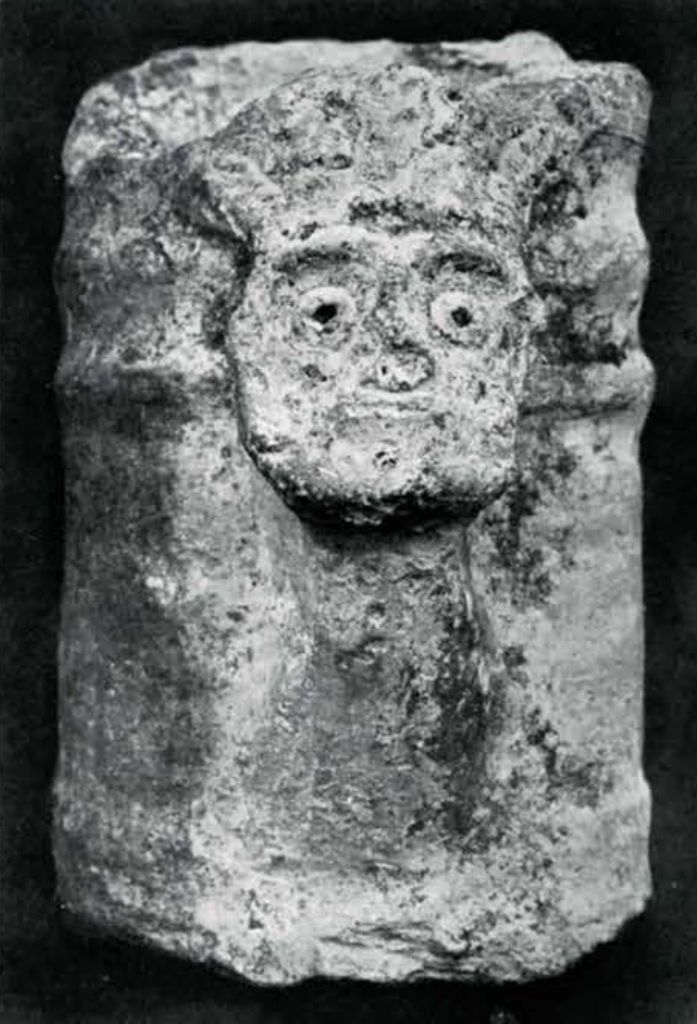
The finds in the Amenophis III level have been particularly rich this season, and include the following classes of objects: (1) Military Weapons, etc. From the undisturbed parts of the level came three bronze axeheads, one of which was associated with a beautiful spear-butt of bronze which is undoubtedly Mediterranean in origin, for examples more or less like it have been found in the cemetery at Beisan and in Egypt, connected in both instances with pottery anthropoid sarcophagi of Mediterranean mercenaries. This butt has a crescent-shaped end and is decorated in high relief with a crossed-string pattern. At its top are two holes for the nails by which the object was affixed to the end of the shaft inserted in it. Another axehead, which is obviously ceremonial, had a fine linen cloth impressed on both sides. Its shape is similar to that of certain smaller votive axes of copper, of Early Minoan III age (2400-2100 B.C.), found at Kumasa in Crete. Other bronze weapons include the curved blade of a scimitar, an arrowhead, and a spearhead. (2) Various Implements, etc. A bronze hoe; a very well made bronze chisel with a square top; a bronze leather-cutter having a semicircular blade and a short tang for the handle; a flint knife set in a plaster handle (a very rare object) ; a basalt paint grinder with traces of red colour on it; and three pieces of blue pigment, are worthy of mention. (3) Pottery. Pottery vessels of all kinds in large numbers, some of them extremely well decorated, have come to light, and it is interesting to note the presence of Mediterranean influence in many of the examples. Sometimes the handles of pots have marks scratched on them. Among the jar stoppers of local manufacture may be mentioned one of clay having impressed on it in two places, a seal in the form of the double-plumes of Egypt (shuly). Some stoppers of clay or mud show quite clearly the marks of the string with which they were attached to the jars. (4) Scarabs. A very good collection of scarabs was found, including two with sphinxes, and various others showing respectively the hawk-headed god Horus, a hawk and a serpent, a scroll design surrounding the emblem of “good luck,” and so on. (5) Cylinder Seals. These are most important. One of them is of Babylonian origin; it is of blue stone and bears three vertical lines of cuneiform, which, according to Pere Dhorme of Jerusalem, read: “Ma-a-nu-um, the diviner, servant of the god En-ki (i.e., Ea).” On one side of the inscription is a figure of the god Ea, and on the other side the figure of the diviner himself. This seal, which contains the first cuneiform inscription found at Beisan, dates somewhere about the XIXth—XVIIIth century B.C. Whether or not Ma-a-nu-um was ever a diviner in one of the earlier sanctuaries which we must assume existed on the tell at Beisan, it is impossible to say. “Diviners” or “soothsayers” are referred to in Jeremiah i, 36, and Isaiah x, liv, 25.8 The Hittite seal mentioned in my last article has now been examined carefully, and I am able to give a fuller description of it than was possible before. On the seal are represented two deities and also an elephant (this is the first occurrence of the animal on cylinder seals) with a vulture above it. Before the elephant stands one of the deities, who holds some object, perhaps an axe, in his right hand. In front of his head is the Hittite hieroglyph which is thought to read “god.” Behind the animal is the other deity, who wears a conical cap. Against the back of his head is the hieroglyph probably meaning “fort.” In front of the latter deity is an ass, near which is some hieroglyph or emblem as yet undecipherable. Another cylinder seal shows six captives with their arms tied behind them; and still another, the figures of two stags and two sacred trees. (6) Various Figurines. These comprise pottery figurines of Ashtoreth; a bronze model of a couchant dog; a painted pottery model of a pig; and a small limestone model of a monkey playing on a pipe. (7) Cult Objects. The pottery cult objects found this season have been particularly important. Most of them came from rooms adjacent to the eastern wall of the Amenophis III temple and may originally have stood upon the mastabahs or low “seats” in the sanctuary of that building. Ten serpent cult objects were discovered altogether, all with one exception (which is a snake’s head) belonging to a single type, which consists of an upright uræus-like serpent on a small stand. One of the serpents has represented on it the breasts of a woman, with a cup below them for milk. This reminds one of the representation of a certain Elamite goddess who holds a bottle between her breasts. The following animals and birds are represented on some of the sacred objects: Bull. The hollow cult object with open base on which the head of this animal appears is cylindrical in shape, and is about 9 I g inches in height. In the old Canaanite religion the bull was generally the emblem of the god. Also the animal itself was used as a sacrifice in the temples, as we see from the remains of the sacrificed bull found in the Thothmes III temple. Elephant. The head of this animal surmounts a hollow cult object the base of which (now missing) must have been cylindrical in shape. This cult object is one of the most remarkable of the cylindrical type found at Beisan. The eyes and trunk of the elephant are very realistically shown. Elephants are frequently referred to in the old Egyptian records. Thus Thothmes II lists them among certain gifts made to him from Upper Syria. An official of Thothmes III, named Amen-em-Heb, mentions that his royal master went to Niy, a district on the western side of the upper Euphrates, where he hunted 120 elephants for the sake of their tusks. A North Syrian elephant is depicted in the tomb of Rekhmara, a vizier of Thothmes III. Elephants were known in the upper Euphrates in the time of the Assyrian king Tiglath-Pileser I (1115 B.c.), while the figure of an elephant is represented on the obelisk of Shalmaneser III, the Assyrian monarch who defeated Jehu the Israelite, in the course of his expedition against Hazael of Damascus, in 842 B.C. Dove. A model of this bird, which was once attached to a kernos or hollow ring of pottery, is of some interest, as it has the tail feathers outlined in red paint. Duck. This bird is represented by two small models of ducks’ heads broken off from some objects not yet identified (lamps?). One of the most interesting of all the cult objects consists of a pointed-base jar surmounted by the head of the Egyptian dwarf god Bes, or Ptah-Seker. This is about 1 S I a inches in height, and is of light red pottery. The dwarf reminds one of the figures of the dwarfs with which, according to Herodotus, iii, 37, the Phoenicians ornamented the prows of their boats: ” [Cambyses] went into the temple of Vulcan, i.e., Ptah, [at Memphis] and made great sport of the image. For the image of Vulcan is very like the Pataeci of the Phoenicians, wherewith they ornament the prows of their ships of war. If persons have not seen these, I will explain in a different way —it is a figure resembling that of a pygmy.” On certain seals, etc., we see the figure of Bes drinking out of a jar, by means of a tube. That this was a Syrian custom at the time of the XVIIIth Dynasty is clearly shown from the stela of a Syrian mercenary drinking from a tube inserted in a large jar on a stand, the tube being presented to him by a servant, and his wife sitting opposite. Another Bes emblem, the model of a human hand found in the Thothmes level, has already been referred to above. Further than this, the foot of the alabaster statuette mentioned on p. 427 of the December JOURNAL is now seen to have belonged to Bes. A most interesting cylindrical cult object unearthed this season has represented on it in high relief the head of Ashtoreth wearing five plumes, reminding one of a plumed Ashtoreth figurine found at Taanach. A pottery plaque having incised on it eight wavy parallel lines representing water, very similar in appearance to a faience plaque of Middle Minoan II era (1900-1700 B.C.) found at Knossos in Crete; and the model of a spherical bread cake bearing the hieroglyphic words “daily offering,” complete the list of cult objects unearthed in the Amenophis III level.
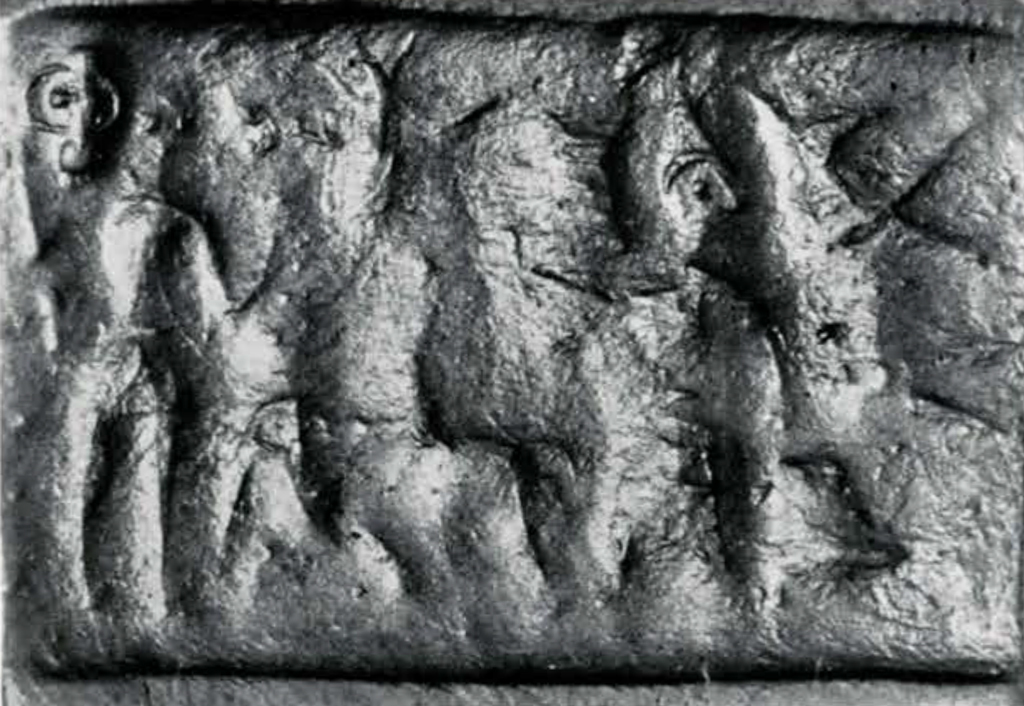
4. Seti I Level: 1313-1292 B.C.
Most of the rooms in the Seti I level, in the area at present being excavated on the east side of the tell, were cleared during the earlier part of the season, and the objects found in them were mentioned in my article in the December number of THE MUSEUM JOURNAL. Since that article was written, however, we have cleared about five small rooms of the same level which were above the Thothmes III, Pre-Amenophis III, and Amenophis III levels situated just to the east of the northern temple of Thothmes III. One of the Seti rooms had the base of a bottle-shaped Byzantine reservoir sunk into it; while still another room, not far from the reservoir, held a great quantity of intrusive Byzantine kitchen refuse, consisting of small fragments of bone, ashes, etc. The objects from these rooms, although not numerous, are interesting, and include the head of an Ashtoreth figurine in limestone; the upper portion of a small cylin-drical(?) cult object with the head of a deity (this object has a horizontal hole in its top for suspension); and a well-made steatite scarab, showing the figure of the god Ptah holding the was-sceptre. An interesting object indicating Mediterranean influence is a pot-handle bearing a seal impression. The seal, which shows the figure of a bearded man or deity holding a club in his left hand, his right arm hanging at his side, is obviously Cycladic. In this level were also found six bricks bearing the impression of a cloven-hoofed animal, evidently a pig, and also a brick bearing a straight-line impression, doubtless a brickmaker’s mark.
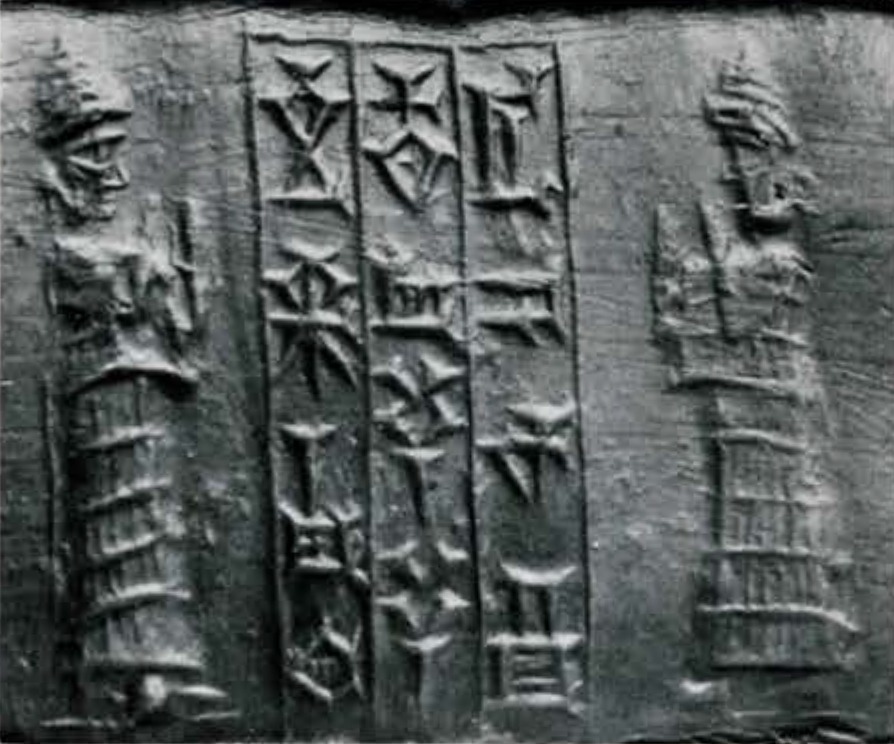
5. Rameses II Level: 1292-1225 B.C.

Museum Object Number: 29-108-362
Image Number: 30182
The rooms of this level excavated since my first article was written were immediately over the Seti I rooms mentioned above, and, like them, contained intrusive Byzantine remains. From them came the figurine of a dove from some cult object; a pottery loom-weight with twenty-four small indentations, arranged in four rows of six in each row, and four bricks with impressions on them. On two of the bricks can be seen a dog’s paw; on another a human foot, and on the fourth the hoof of an animal, perhaps a pig. By far the best object found here was a magnificent green stone scarab, bearing the “throne name” of Rameses II, and showing the figure of the king smiting a Canaanite captive, whom he holds by the arm. The king wears the crown with double plumes, while over his head is the solar disk with two serpents. In front of Rameses are written the words, “Treader-down of foreigners.”
6. Byzantine Level: 330-636 A.D.
The single room of this level excavated towards the latter part of the 1927 season was to the south of the Byzantine reservoir mentioned above. The foundations of the walls of the room, which were of basalt blocks, roughly dressed, were sunk almost down to the Amenophis III level, thereby causing considerable disturbance of the old Egyptian debris. Two of the blocks bear the signs 6 and p, respectively, in red paint. These are merely quarrymen’s marks, each sign doubtless representing a particular gang of labourers. Other letters of the Greek alphabet have been found on Byzantine walls elsewhere on the tell. Quarrymen’s marks are also known in the IVth Dynasty pyramids and temples of Giza, in Egypt, where they were placed in red paint on the large limestone blocks quarried at Tura. Nothing of special interest was found in the Byzantine room, but from the reservoir came two well-ornamented Byzantine lamps; pieces of iron bracelets, two of them accidentally welded together; a neck of a glass bottle; and two pieces of flat glass crumpled by fire.
And now over the great mound of Beisan where the chanting of the temple priests no longer resounds there daily floats across the still air from the village mosque the call to prayer: ” God is the greatest. God is the greatest. God is the greatest. God is the greatest. I testify that there is no god but God. I testify that there is no god but God. I testify that Mohammed is the Apostle of God. I testify that Mohammed is the Apostle of God. Come to prayer. Come to prayer. Come to success. Come to success. God is the greatest. God is the greatest. There is no god but God.” For the worship of the Fierce Devourer and the Queen of Heaven has long passed away and that of the God of Islam and of Israel reigns supreme.
Description of Details of Plan of Temples of Thothmes III
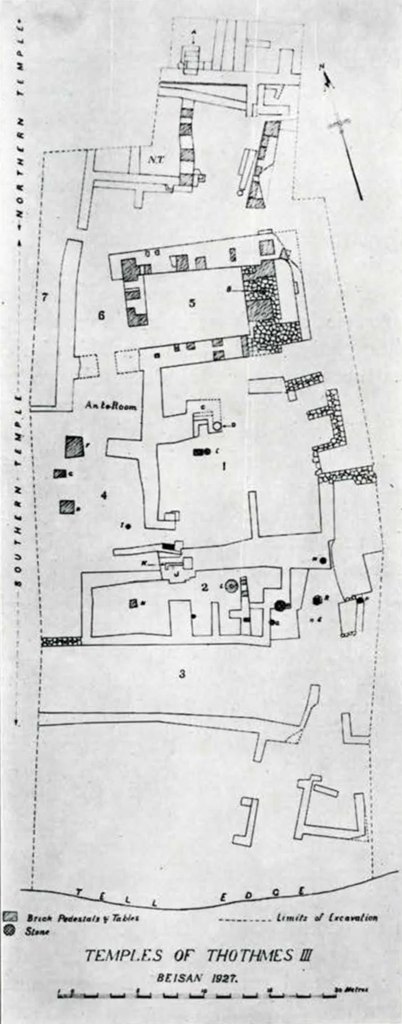
Southern Temple of Thothmes III
- Inner Sanctuary with two altars.
- Room with altar of sacrifice, etc.
- Corridor leading east to room with sacred column.
- Courtyard with tables and pole socket.
- Room north of Inner Sanctuary.
- Corridor leading to Northern Temple.
- Room west of latter corridor.
Northern Temple of Thothmes III
- T. Northern Temple (not yet fully excavated).
- Flight of steps leading to lower level.
Southern Temple of Thotmes III
- Pole socket.
- Brick altar for cult objects.
- Stone libation basin for blood on brick altar.
- Stone altar for meat offerings.
- Brick table for cutting up meat.
- Brick table for implements (?) for cutting up meat.
- Similar to F.
- Socket of pole for dressing carcases of sacrificed animals.
- Brick altar of sacrifice.
- Blood channel in altar. In its centre is indicated the hole for the tethering peg of the animal.
- Clay socket for pot (?).
- Brick pedestal.
- Stone base for cult object (?).
- Stone base for cult object (?).
- Stone base for cult object (?).
- Stone base (?) for the stela of the god Mekal, which was found near by.
- Stone mazzebah, or sacred column emblematic of the temple deity.
- Stone bowl in floor in front of mazzebah. Note: Both mazzebah and bowl are on a brick floor.
1Petrie, Researches in Sinai, p. 126, fig. 134.↪
2Max Muller, Egyptian Mythology, p. 155.↪
3See, e.g., II Kings i, 14. ↪
4See Jeremiah xxxii, 35.↪
5See Pere Vincent, Revue Biblique, 1928, p. 138, quoting Pere Dhorme’s reference to Cuneiform Texts . . . , II, pl. 49, 1.4 s.↪
6THE MUSEUM JOURNAL, 1923, pp. 156, 157.↪
7See Budge, Osiris and The Egyptian Resurrection, i, p. 47.↪
8See the new American Translation of the Old Testament, edited by Professor J. M. Powis Smith.↪

